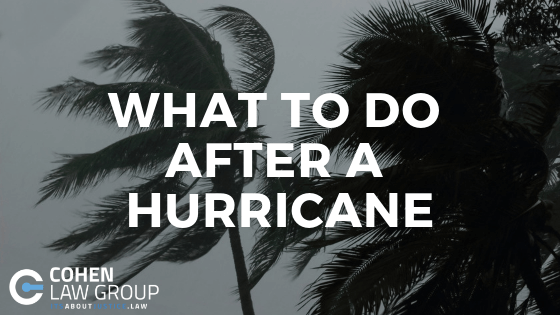What To Do After A Hurricane
It’s hurricane season, and as you may know, September is the month most frequented by named storms in the Atlantic. While you’re gathering up your perishable foods, batteries, and other precious supplies, we here at Cohen Law Group want to make sure you know the steps to take to file an insurance claim if the worst should happen to your home or property.
Here are seven easy steps to follow to help pick up the pieces after the storm:
1. Assess and Record
Once you know that your property has suffered damage, record what is damaged. Write it down and make a list, but also take pictures. You may never know when proof of damage can came in handy when disputing an insurance claim. Additionally, in the case of hurricanes when landfall is predictable, you should also take pictures of your property before the storm to use as comparisons should the need ever arise.
2. Ask Around
Once you’ve documented the damage, damage repair contractors recommend that homeowner’s gather three written proposals for the work from reputable storm repair contractors. The proposals should be written after the contractor performs the full property inspection, including the roof, windows, and AC units.
3. Inspect Your Policy
Read through your insurance policy thoroughly and directly contact your insurance company’s claims department. Offer them any pictures you took, in Step 1 as well as the estimates from Step 2.
4. Request an Inspection
When talking to the claims department, make sure to request that they send an adjuster to inspect the property. Insist that the adjuster inspect the property in the presence of your contractor. The contractor can help to counter any denial made by the adjuster. If the adjuster has an incentive to deny your claim, they will, so make sure the contractor is there to keep them playing fair.
5. Don’t Worry
It’s not the end of the world if your claim gets denied. Homeowner’s are entitled to meet with as many as three adjusters in adjusting their claim. Keep in mind that even if they deny a claim, any damage resulting from a storm covered by the homeowner’s insurance policy should be covered, no matter how small the amount.
6. Receive Payment
For an approved claim, the insurance company will send the you as the homeowner two separate checks. The first will be a materials deposit. The materials ordered by the contractor should be made out in your name, and the contractor should use the check to pay for materials.
7. Make Sure the Job is Satisfactory
The contractor will then do their work. If the contractor needs to make any changes to their original proposal, those changes should be approved by you, the homeowner. Once the contractor’s completed work passes a city inspection, it is up to the homeowner to approve the job, and the contractor will sign lien waiver. At that point, the work is considered complete and the claim closed.
DISCLAIMER: This website is for informational purposes only and does not provide legal advice. Please do not act or refrain from acting based on anything you read on this site. Using this site or communicating with Cohen Law Group through this site does not form an attorney/client relationship. This site is legal advertising. Please review the full disclaimer for more information by clicking here.

